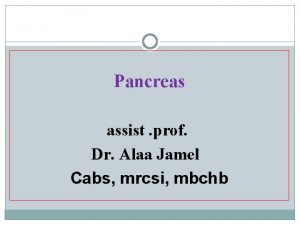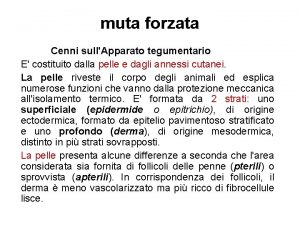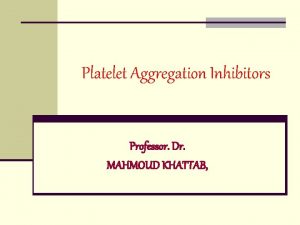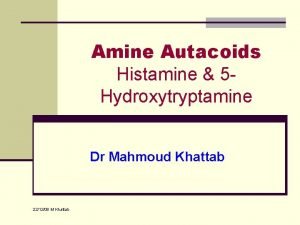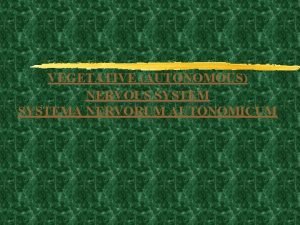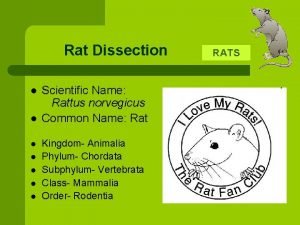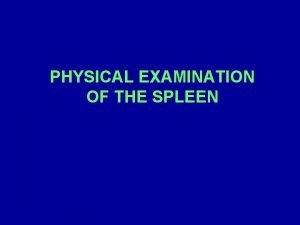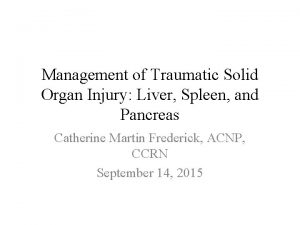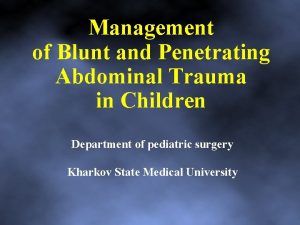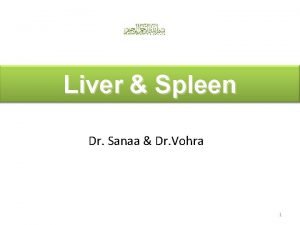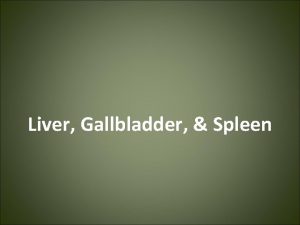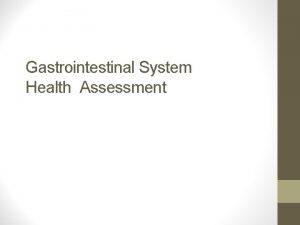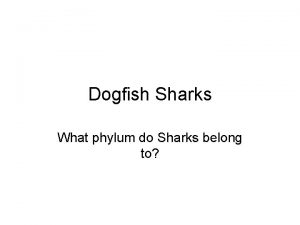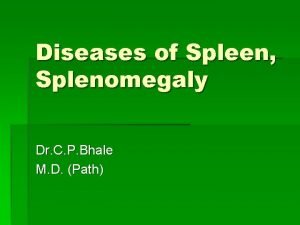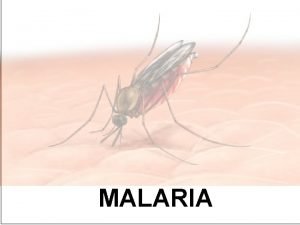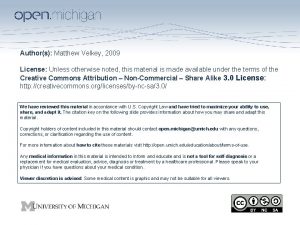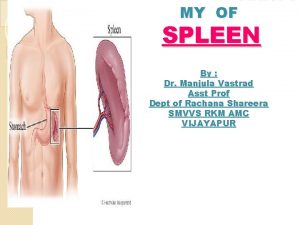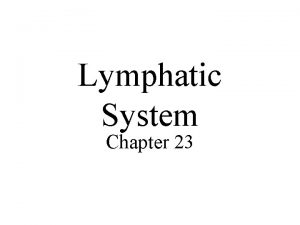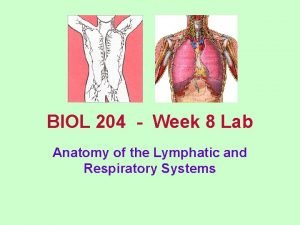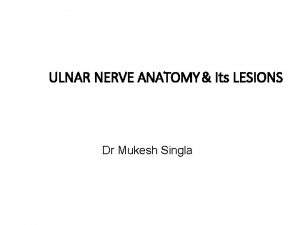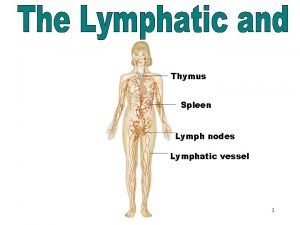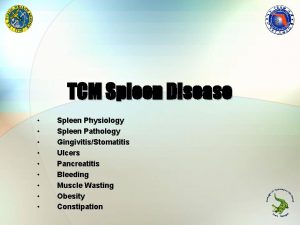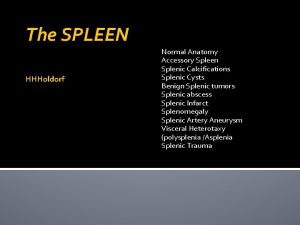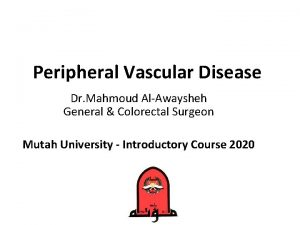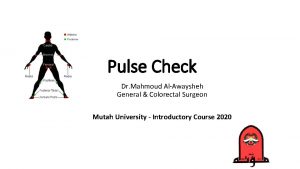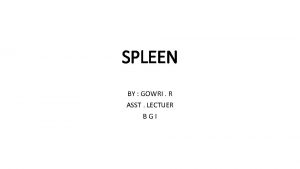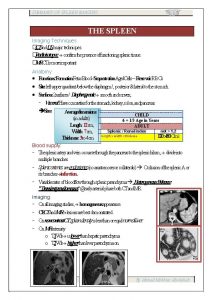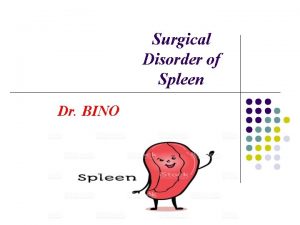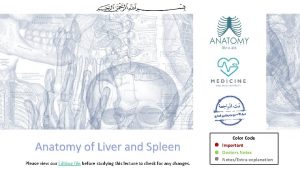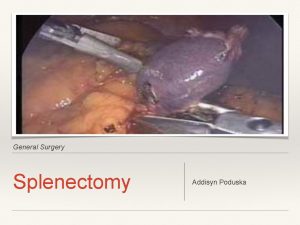Spleen Dr Mahmoud AlAwaysheh MRCSI Muta University Anatomy















































- Slides: 47

Spleen Dr. Mahmoud Al-Awaysheh MRCSI Mu’ta University

Anatomy: Spleen -Wt 75 -250 gm, LUQ, along 10 th rib, between gastric fundus &L hemidiaphragm. -Hilum: In the angle between stomach & L kidney, I n contact with tail of pancreas. -Concave Visceral surface: impressions. -Notch: infero lateral border, palpate in splenomegaly.

- Arterial: Splenic A. along upper border of tail of pancrease. - Vein: Splenic V. at hilum behind pancrease. join SMV to form portal V. - Lymphatics: efferent vessels from white pulp to L N in hilum to retropancrearic to coeliac nodes.




Physiology: Spleen

Functions: Spleen 1. Response to antigenic challenge 2. Destruction of abnormally shaped or rigid red cells 3. Phagocytosis of foreign substance 4. Platelet reservoir 5. Erythrocyte production

Investigation of the Spleen. FBC, Reticulocytes, tests for haemolysis. LFT & OGD in splenomegaly+portal hypertension in liver cirrhosis. Investigations for causes of splenomegaly including LN biopsy. Radiology: 1 -Calcification: splenic infarct, splenic a. aneurysm, hydatid cyst, TB. 2 -US, CT with contrast, MRI. 3 -Tc 99: is spleen site of RBC destruction? .

Congenital Abn of Spleen 1 -Agenesis: rare. 2 -Spleniculi: 10 -30% of population. Hilum (50%), splenic vessels & tail of pancrease (30%), mesocolon & splenic ligaments (20%). **Failure to remove spleniculi during splenectomy…. . persistant disease. 3 -Hamartomas: rare 4 -Non parasitic splenic cyst: 1 -True, dermoid, mesenchymal. 2 -False, trauma 3 - Pseudocyst after pancreatitis.



Consider it : Splenic Rupture 1 -Bunt abdominal trauma LUQ (RTA, Fall, . . . ). 2 -High Risk: diseased or enlarged spleen(rupture of a malarial spleen in trivial injury). 3 -Fractures of 9 th, 10 th, 11 th left ribs. 4 -Iatrogenic. Presentation: 1 -Succumbs rapidly from massive haemorrhage 2 -Initial shock, recovery, signs of late bleeding: Blood loss+tamponade+further bleeding. Reminder are, general signs of internal haemorrhage, local LUQ peritonitis signs, Kehrs sign+FAST US & CT. 3 -Delayed rupture: uncommon with these days scan use In ER.

Splenic rupture Management: 1 -Conservative: 1 -minimal or no abdominal findings+stable haemodynamically. 2 -CT, isolated injury, no hliar injury, no massive distruption of spleen. 2 -Immediate Laparotmy: 1 -continuingblood loss despite adequate resuscitation. 2 -associated abdominal organ injuries with blunt splenic trauma is up to 25 -50%. ******Consider splenic preservation******

Splenic Trauma Spleen Is one of most vascular organs , pass through it 350 liter of blood / day , contain 1 unit of blood at any moment ! Types of trauma : 1 - Blunt 2 - penetrating : Easily diagnosed , because patient almost always referred to Surgery.

Blunt Trauma of Spleen 25% of all blunt trauma of abdominal viscera More in male 3: 2 Most common cause is RTA Presentation : Asymptomatic abdominal pain (50%) , abdominal Distention , Hypotension (25%)

Diagnosis For stable patient : 1. Ultra. Sound 2. CT 3. Angiography

4. Plain radiography / chest and abdomen - The radiography signs of rupture are: 1. Obliteration of the splenic outline 2. Obliteration of the psoas shadow 3. Indentation of the left side of the gastric air bubble 4. Fracture of one or more lower ribs on the left side ( present 27 % of cases 5. Elevation of the left side of the diaphram 6. Free fluid between gas filled intestinal coils.

5. CT Modality of choice Used with contrast. Findings : 1. 2. 3. 4. Lacerations : irregular hypodense area with no enhancement. Sub-capsular hematoma : regular shape , cresentric. Intraparenchymal hematoma. Fragmentation with autosplenictomy.

Diagnosis Unstable patient : Open and See ! Peritoneal lavage FAST

Spleen injury grading scale : Stage 1 : Subcapsular Hematoma < 10 % of surface area. Capsular tear depth < 1 cm.

Spleen injury grading scale : Stage 2 : Subcapsular hematoma of 10 – 50 % of surface area. Laceration depth : 1 -3 cm Not involving trabecular vessels Intraparenchymal Hematoma < 5 cm in Diameter.

Spleen injury grading scale : Stage 3 : Sub-capsular Hematoma > 50 % , or Ruptured spleen. Laceration depth : > 3 cm Involving the trabecular Vessels. Intraparenchymal hematoma > 5 cm in diameter.

Spleen injury grading scale : Stage 4 : Laceration involving hilar or segmental vessels with devascularization of > 25 % of speen

Spleen injury grading scale : Stage 5 : Shattered spleen

Treatment 1. Conservative: Admit patient to ICU Repeated ultrasound For those with stage 1 or 2.

2 - splenectomy 3 - coservative splenoraphy. suturing of spleen to prevent further bleeding. 4 - splenic artery Embolization. - less mortality and morbidity than splenictomy - mortality is related to % of splenic tissue Embolized. - Complications : 1. 2. 3. Pancreatitis Splenic Abscess Pleural Effusion ( most common )




Splenomegaly & Hypersplenism: Clinical syndrome 1 -Splenic enlargement. 2 -Any combination of anaemie, leucopenia or thrombocytopenia. 3 -Compensatory bone marrow hyperplasia. 4 -Improvement after splenectomy.

Splenectomy for Blood ds 1 -ITP: -15 -50 y female. -CP: Ecchymoses purpuric patches of skin & MM. Post traumatic skin petechial haemorrhage. Epistaxis, Menorrhgia. 10% palpable spleen. - Investigations: B. T increased. C. T & P. T normal. Thrombocytopenia.

Treatment 1 -75% regress after 1 st attack in paediatrics. 2 -Steroid for short course in adult & children…recovery 3 - Surgery: Refractory (more than 9 months+low platelet+ 2 relapses). Two thirds cure.

Splenectomy for Blood ds 2 -Haemolytic Anaemias: 1 -Hereditary Spherocytosis. 2 -Sickel cell anaemia. 3 -Thalassaemia. 4 -Acquired autoimmune haemolytic anaemia



Heridatary spherocytosis -Autosomal dominant. spherocytic RBC. -Present in childhood. haemolytic jaundice+splenomegaly+pigment gall stones. -Fragility test RBC haemolyse in stronger saline solution 0. 6%(normally in 0. 47% saline solution). -Reticulocytes increase. -Radioactive Cr 51 labelling RBC. . RBC destruction.

Splenectomy for neoplasms 1 -Haemangioma : Most common benign tumour of spleen Haemangiosarcoma (rare). 2 -Lymphoma: most common cause of neoplastic enlargement. ---Splenectomy is for. . 1 -management. 2 -diagnosis& staging. (CT is alternative for staging). 3 -Myelofibrosis: Abnormal proliferation of mesenchymal elements in BM, spleen, liver & LN. -Over 50, gross splenomegaly with LUQ pain. -Splenectomy reduces the need transfusion & may relieve the pain.



Splenectomy Preop. Investigations: 1 -Blood, FFP, Cryoprecipitate, platelets. 2 -Coagulation profile. 3 -Antibiotic prophylaxis

Splenectomy Post operative complications: 1 -Slipped ligature from splenic a…Haemorrhage. 2 -Haematemesis(gastric mucosal damage) 3 -Gastric dilatation. 4 -Left basal atelectasis & Pleural effusion. 5 -Injury to tail of pancrease. pancreatitis, abscess, fistula. 6 -injury to greater curvature of stomach during ligation short gastric vessels…fistula.

Splenectomy 7 -Venous Thrombosis. *Prophylactic aspirin if platelets more than 1 million* 8 -Post splenectomy septicaemia: 1 -Strep pneumonia. 2 -N meningitides. 3 -H influenzae 4 -E. coli.

Higher Risk Groups: 1 -Young. 2 -Chemoradiotherapy. 3 -Splenectomy for blood dss. 9 - OPSI (overwhelming post splenectomy infection) is a real clinical danger.

Splenectomy OPSI: 1 -Prophylactic daily penicillin if under 5 y until they are 10. 2 -prophylaxis for 2 -3 years if older tha 5 y. Oral Penicillin, Erythromycin, Aomxicillin, Co-Amoxiclav. I. V same A. B above or Cefotaxime, Ceftriaxone or chloramphenicol if allergic to Penicillin or Cephalosporine

Splenectomy * Post operative vaccination give less than 50% antibody levels of those with preoprative vaccination.

Thank You Dr. Mahmoud Al. Awaysheh Mu’ta University
 Uncinate process
Uncinate process Muta metu
Muta metu I sonnambuli clark
I sonnambuli clark Muta forzata galline ovaiole
Muta forzata galline ovaiole Applied anatomy of spleen
Applied anatomy of spleen Mahmoud abdelfattah age
Mahmoud abdelfattah age Passport mahmoud darwish
Passport mahmoud darwish Dr mahmoud salman
Dr mahmoud salman Mahmoud arafa
Mahmoud arafa Boudarene mahmoud
Boudarene mahmoud Mahmoud sarmini md
Mahmoud sarmini md Dr mahmoud khattab
Dr mahmoud khattab Mahmoud khattab md
Mahmoud khattab md Hana mahmoud
Hana mahmoud Spleen referral pattern
Spleen referral pattern Male rat anatomy
Male rat anatomy Traube space
Traube space Spleen solid organ
Spleen solid organ Weinert and kulenkampff sign
Weinert and kulenkampff sign Liver impressions
Liver impressions Gallbladder and spleen location
Gallbladder and spleen location Hilum of liver
Hilum of liver Reticuloendothelial cell
Reticuloendothelial cell Abdominal organs quadrants
Abdominal organs quadrants Latin meaning of phylum and class
Latin meaning of phylum and class Frog internal anatomy
Frog internal anatomy Frog spleen
Frog spleen What phylum is a shark in
What phylum is a shark in Just palpable spleen
Just palpable spleen White pulp
White pulp Eneritis
Eneritis Mcburney's test
Mcburney's test Paul verlaine spleen
Paul verlaine spleen Anatomija stomaka
Anatomija stomaka Stat
Stat Skeletal muscle longitudinal section labeled
Skeletal muscle longitudinal section labeled Dr dahla
Dr dahla Ascites precox causes
Ascites precox causes Spleen function
Spleen function Lig phrenicocolic
Lig phrenicocolic Spleen
Spleen Spleen cat dissection
Spleen cat dissection Pen test in median nerve injury
Pen test in median nerve injury Traube's space
Traube's space Picture of stomach organs
Picture of stomach organs Involuntary muscles
Involuntary muscles Spleniculi
Spleniculi Spleen histology
Spleen histology
